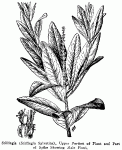Stillingia. Stillingia sylvatica L.
OTHER COMMON NAMES—Queen's-delight, queen's root, silverleaf, nettle-potato.
HABITAT AND RANGE—This plant is found in dry, sandy soil and in pine barrens from Maryland to Florida west to Kansas and Texas.
DESCRIPTION OF PLANT—Like most of the other members of the Spurge family (Euphorbiaceae), stillingia also contains a milky juice. This indigenous, herbaceous perennial is about 1 to 3 feet in height, bright green and somewhat fleshy, with crowded leaves of a somewhat leathery texture. The leaves are practically stemless and vary greatly in form, from lance shaped, oblong, to oval and elliptical, round toothed or saw toothed. The pale yellow flowers, which appear from April to October, are borne in a dense terminal spike and consist of two kinds, male and female, the male flowers arranged in dense clusters around the upper part of the stalk and the female flowers occurring at the base of the spike. The seeds are contained in a roundish 3-lobed capsule.
DESCRIPTION OF ROOT—Stillingia consists of somewhat cylindrical or slenderly spindle shaped roots from 6 inches to a foot in length, slightly branched, the yellowish white, porous wood covered with a rather thick, reddish brown, wrinkled bark, the whole breaking with a fibrous fracture. As found in commerce, stillingia is usually in short transverse sections, the ends of the sections pinkish and fuzzy with numerous fine, silky bast fibres, and the bark showing scattered yellowish brown resin cells and milk ducts. It has a peculiar unpleasant odor, and a bitter acrid and pungent taste.
COLLECTION, PRICES AND USES—Stillingia root is collected late in autumn or early in spring, usually cut into short, transverse sections and dried. The price ranges from 3 to 5 cents a pound.
This root, which is official in the United States Pharmacopoeia, has been a popular drug in the South for more than a century and is employed principally as an alterative.
Ginseng and Other Medicinal Plants, 1936, was written by A. R. Harding.


